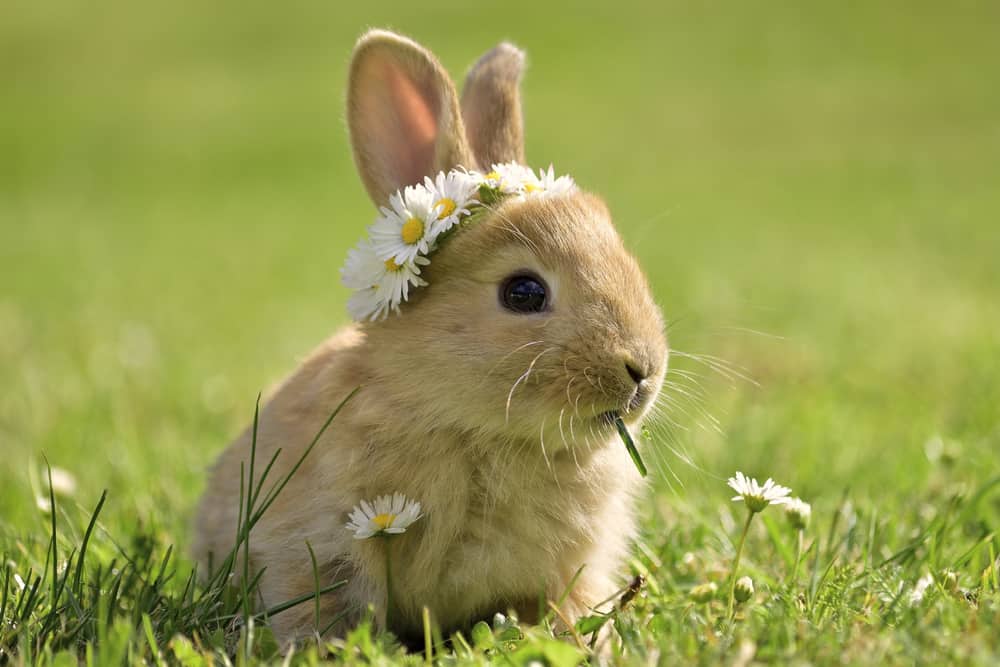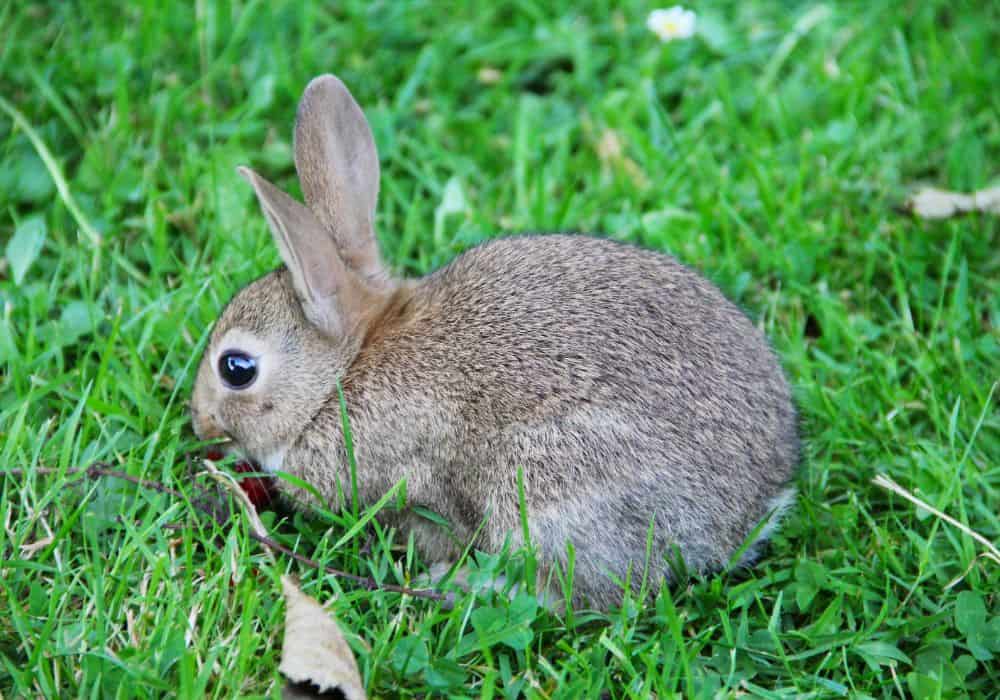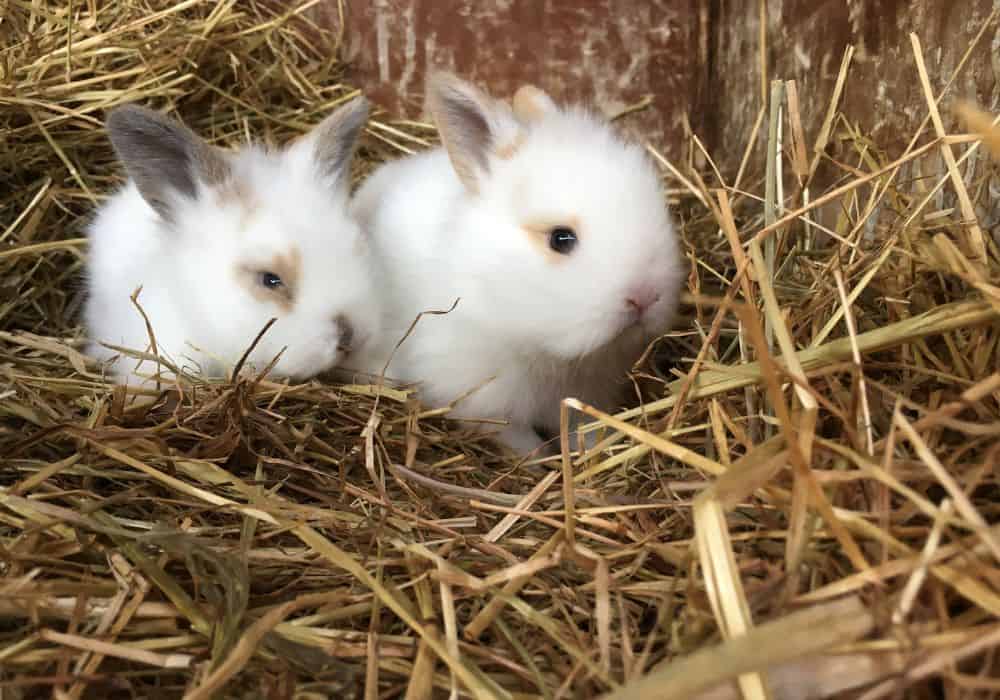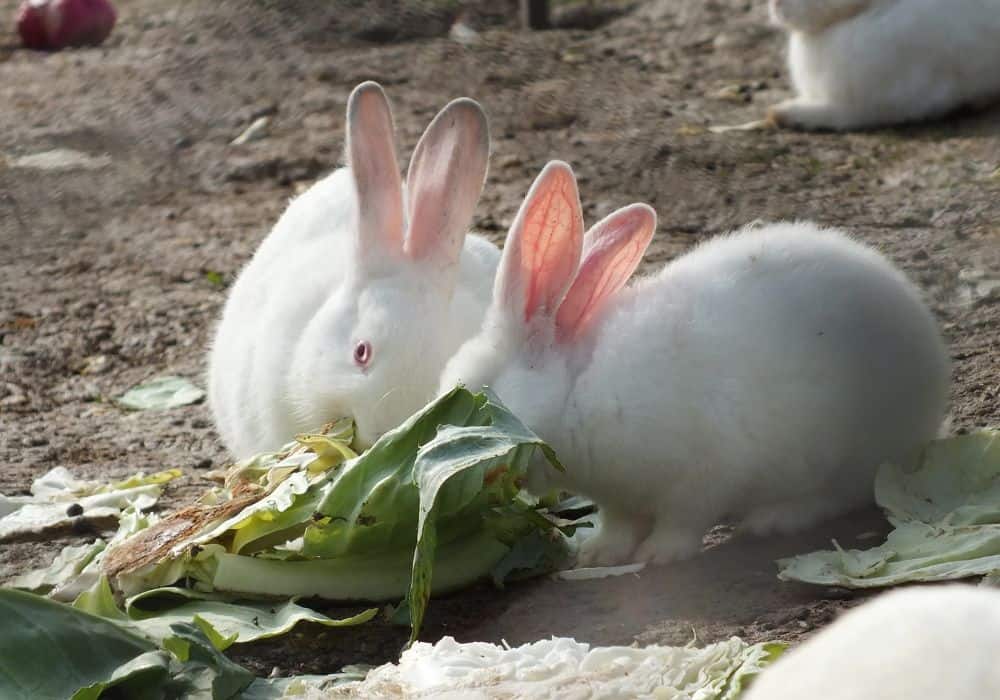If you’ve ever held a baby rabbit, you’ve surely thought they’re some of the cutest animals around. While they may look like stuffed animals, these little critters need the right nourishment to grow, survive, and thrive.
To grow healthily, baby rabbits drink their mother’s milk and eventually eat meadow, timothy, and alfalfa hay, grass, bulbs, and crops. If they’re in captivity, they may munch on commercial pellets and certain vegetables as well.
Let’s dive into what wild and captive baby rabbits eat and what they need to grow.
What Do Wild Baby Rabbits Eat?
Wild baby rabbits, also called kittens or kits, are born blind, hairless, and helpless. They begin their diet by drinking their mother’s milk.
Rabbit’s milk has a much higher fat content than cow’s milk and barely contains any lactose. Most rabbit milk will have 12.9 grams of fat and 12.3 grams of protein per 100 grams of milk. This is the optimal combination for baby rabbits to grow, gaining between 0.5 and 0.75 pounds per week.
When they’re 2-3 weeks old, the kittens begin to consume some solids alongside the milk. During this time, their digestive system begins the delicate process of adjusting to solid foods. They must continue drinking their mother’s milk during this time and will drink it until they’re 6-8 weeks old.
The first solid food baby rabbits usually consume is what’s found in their nest, such as oat hay. By the time they’re 3-4 weeks old, they will drink milk and eat some of the same foods as an adult rabbit.
Once they are large enough to eat solid foods and roam around the nest, baby rabbits become grazers. Grazers are herbivores that feed on low-growing plants or multicellular organisms. These plants include meadow and timothy hay, alfalfa, grass, crops, bulbs, and even bark.
Rabbits consume foods that are difficult to digest – even for their intestinal tract – which is why they must consume their food twice. They will eat their soft droppings, digesting their food again until they excrete hard pellets.
What Do Captive Baby Rabbits Eat?
Captive rabbits can have two types of diets: one for wild rabbits that have been rescued and one for domesticated baby rabbits. If they are not yet weaned, both types of rabbits will need to consume formula instead of their mother’s milk.
For captive baby rabbits that have been rescued from the wild, purchase kitten replacement milk specifically, as other formulas may not have the nutrients needed to keep the baby rabbit alive. Mix one can of this milk with a tablespoon of sugar-free heavy whipping cream and feed it to the baby rabbit twice a day through a syringe or eyedropper.
As the baby wild rabbits grow, feed them oat and timothy hay, fresh leafy greens like carrot tops or dandelion greens, alfalfa, and parsley. Introduce solid foods slowly and look out for digestive issues like diarrhea or illness in the kittens.
Domestic baby rabbits, on the other hand, can combine formula with timothy and oat hay, alfalfa, and pellets. Pellets are grass-based commercial feed for rabbits that combine and process natural ingredients into pellet form for domestic rabbits to eat. They usually have a lot of fiber and not much protein.
Remember that rabbits practice coprophagia, which is the consumption of their own droppings. Be sure to leave soft droppings in a corner of their enclosure so they can eat them later on.
How Much and How Often Do Baby Rabbits Eat?
Baby rabbits are fed milk by their mothers twice a day, usually at dawn and dusk when the mother returns to the nest. Each feeding will only last a few minutes, which is scarce compared to the feedings of other baby animals; however, with such nutrient-dense milk, baby rabbits don’t need much more than this to survive.
Once baby rabbits start to eat hay and other solid foods, they’ll nibble to their liking until they’re full.
If you have found a baby rabbit that was abandoned by its mother, you’ll need to feed it formula to survive. The newborn rabbits will need to consume the following amounts of formula twice a day:
- Rabbits 0-7 days of age: 4-5 cc
- 1-2 weeks old: 10-15 cc
- 2-3 weeks old: 15-30 cc
- 3 weeks old until they’re weaned: 30 cc
Once its eyes are open or around 10 days after birth, a baby rabbit can be fed some solid foods. Whether you’re incorporating pellets or grasses, the rabbits will eat as much as they need to feel satiated. Be sure to remove any uneaten food from the enclosure, especially greens, before they rot.
Whatever food choices you decide on, be sure that your young rabbits’ diet consists of at least 16% protein. This will ensure it grows steadily and strongly.
What Not to Feed Baby Rabbits
Baby rabbits are very sensitive to changes in their diet. Whether you’re following a diet for wild or domestic baby rabbits, always incorporate new foods slowly and in small amounts. If you notice that the rabbits take well to them, continue. If you notice that the rabbits don’t eat the food or eat it and experience adverse effects, remove the food from their enclosure and diet.
Wild baby rabbits should not be given pellets. Their digestive systems will react more positively to the real thing – in this case, hays, grasses, and alfalfa. While you can incorporate some veggies into their diet, baby rabbits should primarily be consuming natural grasses or greens.
Both domestic and wild baby rabbits should not be fed certain vegetables. Potatoes, mushrooms, kale, broccoli, rhubarb, iceberg lettuce, leeks, avocados, raw onions, garlic, and kidney beans could be poisonous or harmful to rabbits. Avoid feeding them meat or any dairy that isn’t baby rabbit formula. Human foods, such as chocolate or candy, should also be kept away from any pets or rescued animals.
Tips for Keeping Baby Rabbits as Pets
If you recently adopted baby rabbits, use these tips to help them live long and healthy lives in your home.
- Most mother rabbits never abandon their babies, so think twice before removing baby rabbits from a nest. Since the mother feeds them only once or twice a day and avoids staying in the nest to attract predators, spotting her may be difficult. You can spot abandoned babies if they have sunken stomachs and are not plump.
- Baby rabbits don’t need their mother to lay next to them, as they can maintain their warmth in the nest without her. Recreate this environment by placing a box filled with hay, non-chemical grass clippings, or leaves in your rabbit cage. Clean out the hay and grass every 3-4 days.
- Avoid touching your baby rabbits too much, as they have been known to die of stress if carried improperly.
- Baby rabbits feed on their backs, so you can try to replicate the position when hand-feeding your pet.
- Most rabbits will use a litter tray once they leave the “nest,” if you supply one. This makes cleaning out droppings much easier.
- Male rabbits will become territorial once they reach sexual maturity. Eighty percent of un-spayed female rabbits will develop uterine cancer. If you plan to have your pet rabbits neutered or spayed, consider doing so between 4 and 6 months old.
Conclusion
Baby rabbits are adorable animals who require a very particular diet to survive and thrive. Their mother’s milk is a staple until they are about 6-8 weeks old, as it has a high-fat content and plenty of protein to promote healthy growth.
As the baby rabbit begins to incorporate solid foods into its diet, it will munch on hays, grasses, and alfalfa. Those in captivity may also begin to eat commercial pellets made of similar ingredients.
Remember that baby rabbits are best left under the care of their mothers, but if you find an abandoned bunny, follow these diet and care tips to keep them healthy and strong.
FAQ:
1. Can Baby Bunnies Drink Water?
Baby bunnies can begin to sip water at around three to four weeks old in captivity. They will likely drink it themselves from a rabbit water bottle or water bowls.
If they are in the wild, baby bunnies stay hydrated through their mother’s milk. Once they leave the nest or burrow or wean off the milk, they will sip at any available water sources.
2. What Do You Feed a Baby Rabbit Without a Mother?
If you need to care for a baby rabbit that doesn’t have a mother, you’ll need to buy a syringe or eyedropper, rabbit formula (called kitten replacement milk), and hay. You can also purchase optional sugar-free heavy whipping cream to mix with the milk for optimal nutrient density.
After about two to three weeks, you can incorporate the grasses into the baby rabbit’s diet. Add new food items one at a time and in small quantities and observe how the rabbit reacts to each meal. Then, adjust as necessary.
As the rabbit becomes comfortable eating hays and alfalfas, you can also feed it some commercial pellets and even some leafy green vegetables or herbs like basil.
3. What Do You Feed a Wild Baby Rabbit?
Wild baby rabbits should be fed the same as baby rabbits without a mother, except they should steer clear of pellets. Wild rabbits’ digestive systems will be more accustomed to grasses and hay as opposed to processed pellets which may not be digested properly.
Never feed your wild rabbit human food, meat, or dairy apart from their formula.



